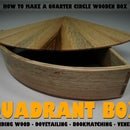Introduction: Make a Mortise & Tenon Joint (Stub)
In the stub mortise and tenon joint, neither mortise nor tenon extend through the mortised component. It is used where a through mortise and tenon would detract from the appearance of the structure, and where joint strength is not so important.
Keep reading to see how to make one.
Step 1: Here's a Video of the Process
This was one of my early YouTube videos, so please excuse the quality.
I include it here in case it helps you to understand the process more.
Step 2: Prepare Components
Components are prepared square and true. That is to say, the areas where the joint is to be made are prepared with four flat sides, all at ninety degrees to one another, and with a flat end at ninety degrees to all four sides.
For more information on how to do that, you can always watch my video series on wooden component preparation:
https://www.youtube.com/playlist?list=PL86lqISCtD7r8iXGmpBaq_biqWVeoyPVF
Step 3: Select the Mortise Chisel & Set the Mortise Gauge
A mortise chisel is selected which is approximately one third the component thickness, and a mortise gauge's pins set the same distance apart.
The mortise gauge stock (fence) is set to position the mortise in the middle of the component's thickness.
Step 4: Set the Length of the Tenon
The tenon shoulders are positioned so that the end of the tenon remains a good distance away from the opposite edge of the mortise component (we don't want it to go right through!).
Keep the tenon length at least 3/16" less than the thickness in which you plan to make the mortise.
Step 5: Knife the Shoulder Lines
The tenon shoulder lines are knifed in, with a marking knife and try-square, all around. This defines the volume in which we will prepare the tenon.
Step 6: Gauge Tenon Cheeks
The tenon cheeks are gauged in from the 'face side', with the mortise gauge, on the two edges and on the end.
A 'face side' refers to a single side of each component. It is used throughout, along with a face edge (a side at ninety degrees to it), for measurements and marking, to ensure accuracy.
Step 7: Mark Out Mortise
The mortise sides are gauged in from the 'face side', with the mortise gauge, without changing the pin positions.
Define the ends of the mortise with two knife lines, using a try square.
Step 8: Chop the Mortise
Mark the mortise depth onto the chisel, so you know when you've gone deep enough.
Starting a little way in from the mortise ends (1/4" in softwood, 1/8" in hardwood, at least), to help preserve the knife line position when levering, excavate the middle of the mortise.
This is done by first striking the chisel in a vertical position, with the bevel pointing towards the center of the mortise, and the chisel between the gauged lines. The chisel is then moved perhaps 1/4" towards the other end of the mortise, and struck again. This time the chisel is pushed first towards the last cut, and then pulled back towards the other end, levering out a chip. This process is simply repeated from each end, at deeper and deeper levels, until the correct depth is achieved.
Now the ends of the mortise are cut back to the knife lines, with light cuts to prevent shifting the line (this can happen because the bevel on the chisel acting on the waste, converts some of the downward force into a horizontal force towards the mortise end). These cuts should be perfectly vertical by the time the end is reached, and a try square sat next to the work will help guide you.
This step may seem daunting, and it can take some practice to master. Watching the video may help you visualize the actions.
Step 9: Saw Tenon Cheeks
Saw down the tenon cheek lines left by the gauge, keeping the kerf (gap left by saw when cutting) on the waste side of the lines.
Sawing more in the waste will be okay, and is easily recoverable. But sawing inside the gauge lines will require you to glue a block on the 'skinny' tenon and saw it again.
Step 10: Saw Tenon Shoulders
Create a knife wall, against which you can guide the saw, by paring into the base of the knifed shoulder lines from the waste.
Then saw the shoulders, releasing the waste from both faces.
Step 11: Thickness Tenon to Fit
If you've sawn the tenon a little thick (not right up to the gauge line), then it will be too tight for the mortise. (The same result occurs if you set the mortise gauge pins a little too wide.)
This is easily remedied by paring the tenon faces with a wide chisel, or using a shoulder plane or router plane. You should be sure to first pare down to the gauged lines on each face, and then pare equally from each face until the tenon fits.
Step 12: Saw Tenon to Width
Mark the tenon faces for width directly from the mortise, and then saw the tenon to width.
Step 13: Clean Up Shoulders and Assemble
Pare back any waste at the shoulders to the knifed shoulder lines.
This should ensure your joint lines are nice and tight.
Step 14: Ready to Glue Up
The joint is finished, and you're ready to glue it up.
Thanks for looking at my Instructable. I hope you found it useful. Like it and share it if you believe it worthy.





